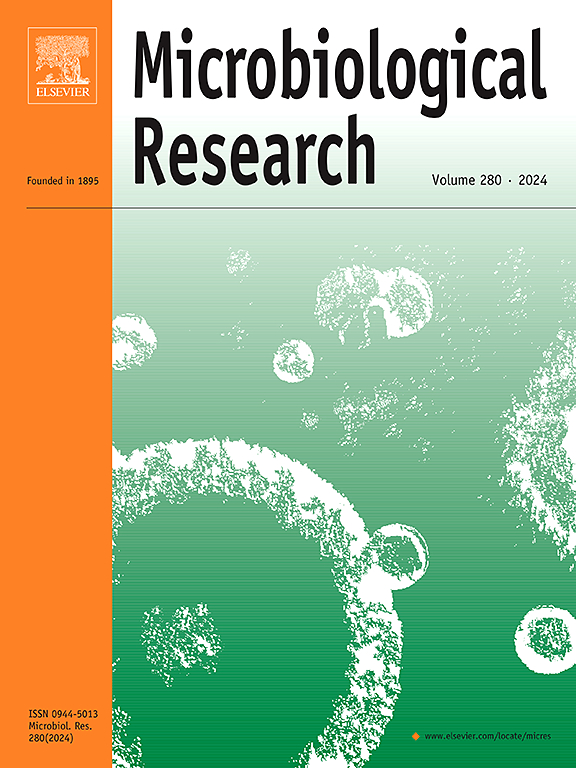肠道核心微生物物种长双歧杆菌:定植、机制和健康益处
IF 6.1
1区 生物学
Q1 MICROBIOLOGY
引用次数: 0
摘要
长双歧杆菌(B. longum)是人类肠道核心微生物组的一个物种,其丰度与宿主的年龄和健康状况密切相关。研究表明,长双歧杆菌能调节宿主肠道微生态,并具有缓解各种疾病的潜力。全面了解长春花酵母菌的定植机制以及宿主与长春花酵母菌之间的相互作用机制,可为通过长春花酵母菌导向策略预防和治疗人类疾病提供可能。在这篇综述中,我们总结了长春花酵母菌的肠道定植特征,讨论了有能力/有潜力富集本地和/或摄入的长春花酵母菌菌株的饮食因素,并回顾了长春花酵母菌在多种疾病中的干预机制。主要发现如下:首先,长春芽孢杆菌具有专门的定植机制,如广泛的碳水化合物利用谱使其能够适应宿主的饮食、编码胆盐水解酶(BSHs)的物种级保守基因以及适当的细菌表面结构。其次,膳食干预(如花青素)可有效改善龙胆球菌的肠道定植,证明了膳食调整菌株定植的可行性。最后,我们分析了长春花酵母菌在不同类型疾病中的偏态丰度,并总结了长春花酵母菌缓解消化系统疾病(通过刺激Paneth细胞活性修复肠粘膜屏障)、免疫系统疾病(上调调节性T细胞(Treg)数量并维持Th1/Th2平衡)和神经系统疾病(通过肠脑轴调节脑内犬尿氨酸途径和喹啉酸水平)的主要机制。本文章由计算机程序翻译,如有差异,请以英文原文为准。
The gut core microbial species Bifidobacterium longum: Colonization, mechanisms, and health benefits
Bifidobacterium longum (B. longum) is a species of the core microbiome in the human gut, whose abundance is closely associated with host age and health status. B. longum has been shown to modulate host gut microecology and have the potential to alleviate various diseases. Comprehensive understanding on the colonization mechanism of B. longum and mechanism of the host-B. longum interactions, can provide us possibility to prevent and treat human diseases through B. longum-directed strategies. In this review, we summarized the gut colonization characteristics of B. longum, discussed the diet factors that have ability/potential to enrich indigenous and/or ingested B. longum strains, and reviewed the intervention mechanisms of B. longum in multiple diseases. The key findings are as follows: First, B. longum has specialized colonization mechanisms, like a wide carbohydrate utilization spectrum that allows it to adapt to the host's diet, species-level conserved genes encoding bile salt hydrolase (BSHs), and appropriate bacterial surface structures. Second, dietary intervention (e.g., anthocyanins) could effectively improve the gut colonization of B. longum, demonstrating the feasibility of diet-tuned strain colonization. Finally, we analyzed the skewed abundance of B. longum in different types of diseases and summarized the main mechanisms by which B. longum alleviates digestive (repairing the intestinal mucosal barrier by stimulating Paneth cell activity), immune (up-regulating the regulatory T cell (Treg) populations and maintaining the balance of Th1/Th2), and neurological diseases (regulating the kynurenine pathway and quinolinic acid levels in the brain through the gut-brain axis).
求助全文
通过发布文献求助,成功后即可免费获取论文全文。
去求助
来源期刊

Microbiological research
生物-微生物学
CiteScore
10.90
自引率
6.00%
发文量
249
审稿时长
29 days
期刊介绍:
Microbiological Research is devoted to publishing reports on prokaryotic and eukaryotic microorganisms such as yeasts, fungi, bacteria, archaea, and protozoa. Research on interactions between pathogenic microorganisms and their environment or hosts are also covered.
 求助内容:
求助内容: 应助结果提醒方式:
应助结果提醒方式:


